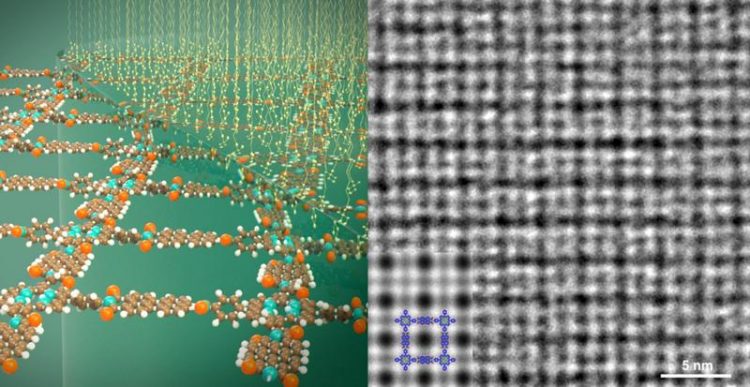Bottom-up Synthesis of Crystalline 2D Polymers: A Dream Finally Comes True

Left: Schematic illustration for the SMAIS method for 2D polymer synthesis, Right: High-resolution transmission electron microscopic image for 2D polyimide Left: by Marc Hermann, TRICKLABOR), Right: by Dr. Haoyuan Qi, Uni Ulm
Ever since Hermann Staudinger discovered the linear polymers in 1920, it has been a dream of synthetic scientists to extend the polymerization into the second dimension.
A two-dimensional (2D) polymer is a sheet-like monomolecular macromolecule consisting of laterally connected repeat units with end groups along all edges. Given the enormous chemical and structural diversity of the building blocks (i.e., monomers), 2D polymers hold great promise in the rational material design tailored for next-generation applications, such as membrane separation, electronics, optical devices, energy storage and conversion, etc.
However, despite the tremendous developments in synthetic chemistry over the last century, the bottom-up synthesis of 2D polymers with defined structures remains a formidable task.
Since 2014, a group of scientists from Technische Universität Dresden and Ulm University Ulm joined forces to pursue this intriguing yet challenging goal. The research team led by Prof. Dr. Xinliang Feng (TU Dresden) innovatively developed a novel synthetic route: using surfactant monolayer as a soft template to guide the supramolecular organization of monomers and the subsequent 2D polymerization at an air-water interface.
This synthetic methodology is now termed as surfactant-monolayer-assistant interfacial synthesis (SMAIS). By using the SMAIS method, Dr. Tao Zhang synthesized crystalline quasi-2D polyaniline films with lateral size ~50 cm2 and tunable thickness (2.6 – 30 nm).
The superior charge transport properties and chemiresistivity toward ammonia and volatile organic compounds render the quasi-2D polyaniline films as promising electroactive materials for thin-film organic electronics. To further explore the potential of SMAIS, Mr. Kejun Liu, Dr. Tao Zhang, Dr. Zhikun Zheng and Dr. Renhao Dong achieved controlled synthesis of highly-crystalline few-layer 2D polyimide and polyamide for the first time.
The 2D polymers have a thickness of only a few nanometers and can be readily transferred onto arbitrary substrates, opening up exciting opportunity for the integration of 2D polymers into next-generation devices and systems.
Along with the pivotal developments on the synthesis front, the transmission electron microscopy group led by Prof. Dr. Ute Kaiser (Ulm University) provided another indispensable pillar of the joint research. Since the development of aberration correction, high-resolution TEM imaging has been a powerful technique in structural characterization down to the atomic scale.
Yet, hydrogen-containing organic materials are extremely prone to structural disintegration under the electron beam, rendering HRTEM imaging of 2D polymers a highly demanding mission.
By utilizing the spherical-aberration-corrected HRTEM, Dr. Haoyuan Qi has successfully unraveled the micro-morphology, molecular structures, grain boundary and edge structures, of the synthetic 2D polymers: an achievement which is rarely reported in literature.
The molecular structures and overall crystallinity have been further elucidated via synchrotron grazing-incidence X-ray scattering (cfaed Chair for Organic Devices, Prof. Dr. Stefan Mannsfeld, TU Dresden). The group of Prof. Dr. Thomas Heine (TU Dresden) provided density-functional tight-binding calculations which offers significant insights into the atomistic structures of the synthetic 2D polymers.
This fruitful results of the joint research have been published this week on Nature Chemistry (DOI: 10.1038/s41557-019-0327-5) and Nature Communications (DOI: 10.1038/s41467-019-11921-3) in tandem.
Acknowledgment:
The authors gratefully acknowledge financial support by ERC Grant on T2DCP and EU Graphene Flagship, COORNET (SPP 1928), CONJUGATION-706082 as well as the German Science Council, Centre of Advancing Electronics Dresden, EXC1056, (cfaed) and OR 349/1. Haoyuan Qi and Ute Kaiser thank the financial support by the DFG in the framework of the “SALVE” (Sub-Angstrom Low-Voltage Electron Microscopy) project as well the Ministry of Science, Research and the Arts (MWK) of Baden-Wuerttemberg in the framework of the SALVE project. Kejun Liu thanks the China Scholarship Council (CSC) for the financial support.
Prof. Xinliang Feng
Chair for Molecular Functional Materials
Phone: +49-(0)351-463-43251
E-mail: xinliang.feng@tu-dresden.de
Matthias Hahndorf
cfaed, Head of Public Relations
Phone: +49-(0)351-463-42847
E-mail: matthias.hahndorf@tu-dresden.de
Kejun Liu et al: On-water surface synthesis of crystalline two-dimensional polymers assisted by surfactant monolayers. Nature Chemistry (2019). DOI: 10.1038/s41557-019-0327-5.
https://www.nature.com/articles/s41557-019-0327-5
Dr. Tao Zhang et al: Engineering Crystalline Quasi-Two-Dimensional Polyaniline Thin Film with Enhanced Electrical and Chemiresistive Sensing Performances. Nature Communications (2019), DOI: 10.1038/s41467-019-11921-3.
https://www.nature.com/articles/s41467-019-11921-3
Media Contact
All latest news from the category: Life Sciences and Chemistry
Articles and reports from the Life Sciences and chemistry area deal with applied and basic research into modern biology, chemistry and human medicine.
Valuable information can be found on a range of life sciences fields including bacteriology, biochemistry, bionics, bioinformatics, biophysics, biotechnology, genetics, geobotany, human biology, marine biology, microbiology, molecular biology, cellular biology, zoology, bioinorganic chemistry, microchemistry and environmental chemistry.
Newest articles

Superradiant atoms could push the boundaries of how precisely time can be measured
Superradiant atoms can help us measure time more precisely than ever. In a new study, researchers from the University of Copenhagen present a new method for measuring the time interval,…

Ion thermoelectric conversion devices for near room temperature
The electrode sheet of the thermoelectric device consists of ionic hydrogel, which is sandwiched between the electrodes to form, and the Prussian blue on the electrode undergoes a redox reaction…

Zap Energy achieves 37-million-degree temperatures in a compact device
New publication reports record electron temperatures for a small-scale, sheared-flow-stabilized Z-pinch fusion device. In the nine decades since humans first produced fusion reactions, only a few fusion technologies have demonstrated…





















